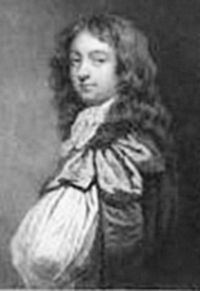Ford Grey, 1st Earl of Tankerville

Ford Grey, 1st Earl of Tankerville (20 July 1655 – 24 June 1701), 1st Viscount Glendale, and 3rd Baron Grey of Warke, was an English nobleman and statesman.
Life
Grey was the eldest son of Ralph Grey, 2nd Baron Grey of Werke and Catherine Ford, daughter of Sir Edward Ford of Harting in West Sussex. He was baptised the day of his birth at Harting. His family seat was Chillingham Castle in Northumberland, which he inherited on his father's death in 1675.
In 1682 Grey achieved notoriety for being found guilty of seducing his wife's sister, Lady Henrietta Berkeley for which he was arrested, tried and ultimately freed. In 1683 he was arrested for involvement in the Rye House Plot but escaped from the Tower of London in July and fled with Lady Henrietta and her new husband to France. He later became one of the leaders of the Monmouth Rebellion, landing with Monmouth at Lyme Regis in June 1685. He was in command of the cavalry, and its defeat on two occasions may have been caused by his cowardice, possibly even by his treachery. He was taken prisoner and condemned for high treason, but he obtained a pardon by freely giving evidence against his former associates, and was restored to his honours in June 1686.
During the reign of William III he was made Privy Councillor on 11 May 1695 and, on 11 June 1695, created Viscount Glendale and Earl of Tankerville. From 1695 till his death he was a Commissioner of Greenwich Hospital; from November 1699 till November 1700, First Lord of the Treasury. During the absence of the King from June till October 1700, he was a Lord Justice of the Realm, and from November 1700 till his death, Lord Privy Seal. He died on 24 June 1701.
Third creation of earldom
Grey married Lady Mary Berkeley, daughter of George Berkeley, 1st Earl of Berkeley and his wife, Elizabeth Massingberd. Their elder surviving child, Lady Mary Grey, was born about 1678. She married, on 3 July 1695, Charles Bennet, 2nd Lord Ossulston, later created 1st Earl of Tankerville, new creation, and died on 31 May 1710. Their second daughter Lady Annabella Grey married, in 1697, John Cecil, 6th Earl of Exeter but died in August 1698 leaving no children. After Grey's death, Lady Mary married Richard Rooth of Epsom.
In Sir Arthur Conan Doyle's novel about the Monmouth Rebellion, Micah Clarke (1889), Grey is represented as the character Lord Grey of Warke. In Aphra Behn's epistolary novel, Love-Letters Between a Nobleman and His Sister, Grey is represented as the character Philander.[1]
References
- ↑ Ellen, Pollak (2003). Incest and the English Novel, 1684-1814. Baltimore, Maryland: The Johns Hopkins University Press. p. 280. ISBN 0801872049.
External links
- The Trial of Lord Ford Grey of Werk
- Greaves, Richard L. "Grey, Ford, earl of Tankerville (bap. 1655, d. 1701)", Oxford Dictionary of National Biography, Oxford University Press, 2004; online edition, May 2009 doi:10.1093/ref:odnb/11531 (subscription or UK public library membership required)
| Political offices | ||
|---|---|---|
| Preceded by Charles Montagu |
First Lord of Treasury 1699–1700 |
Succeeded by Sidney Godolphin |